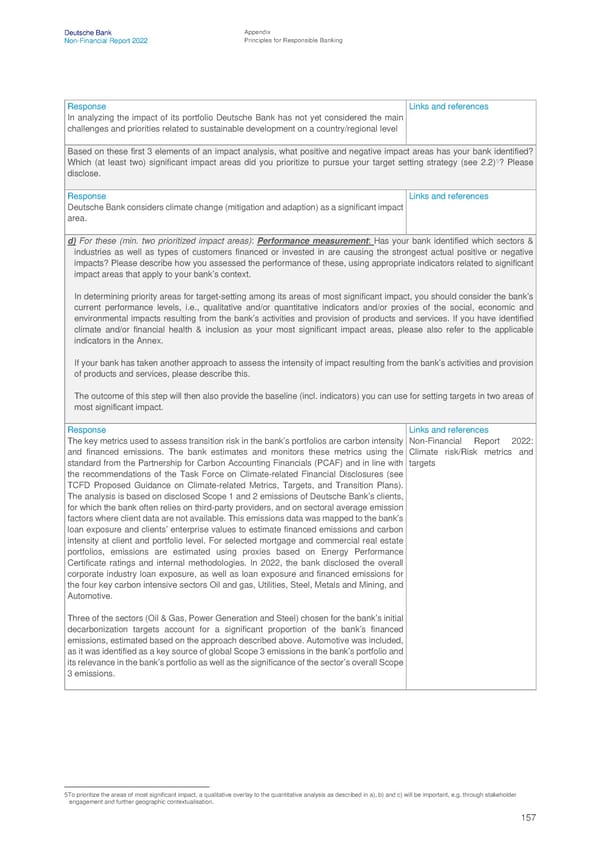Deutsche Bank Appendix Non-Financial Report 2022 Principles for Responsible Banking Response Links and references In analyzing the impact of its portfolio Deutsche Bank has not yet considered the main challenges and priorities related to sustainable development on a country/regional level Based on these first 3 elements of an impact analysis, what positive and negative impact areas has your bank identified? 5 Which (at least two) significant impact areas did you prioritize to pursue your target setting strategy (see 2.2) ? Please disclose. Response Links and references Deutsche Bank considers climate change (mitigation and adaption) as a significant impact area. d) For these (min. two prioritized impact areas): Performance measurement: Has your bank identified which sectors & industries as well as types of customers financed or invested in are causing the strongest actual positive or negative impacts? Please describe how you assessed the performance of these, using appropriate indicators related to significant impact areas that apply to your bank’s context. In determining priority areas for target-setting among its areas of most significant impact, you should consider the bank’s current performance levels, i.e., qualitative and/or quantitative indicators and/or proxies of the social, economic and environmental impacts resulting from the bank’s activities and provision of products and services. If you have identified climate and/or financial health & inclusion as your most significant impact areas, please also refer to the applicable indicators in the Annex. If your bank has taken another approach to assess the intensity of impact resulting from the bank’s activities and provision of products and services, please describe this. The outcome of this step will then also provide the baseline (incl. indicators) you can use for setting targets in two areas of most significant impact. Response Links and references The key metrics used to assess transition risk in the bank’s portfolios are carbon intensity Non-Financial Report 2022: and financed emissions. The bank estimates and monitors these metrics using the Climate risk/Risk metrics and standard from the Partnership for Carbon Accounting Financials (PCAF) and in line with targets the recommendations of the Task Force on Climate-related Financial Disclosures (see TCFD Proposed Guidance on Climate-related Metrics, Targets, and Transition Plans). The analysis is based on disclosed Scope 1 and 2 emissions of Deutsche Bank’s clients, for which the bank often relies on third-party providers, and on sectoral average emission factors where client data are not available. This emissions data was mapped to the bank’s loan exposure and clients’ enterprise values to estimate financed emissions and carbon intensity at client and portfolio level. For selected mortgage and commercial real estate portfolios, emissions are estimated using proxies based on Energy Performance Certificate ratings and internal methodologies. In 2022, the bank disclosed the overall corporate industry loan exposure, as well as loan exposure and financed emissions for the four key carbon intensive sectors Oil and gas, Utilities, Steel, Metals and Mining, and Automotive. Three of the sectors (Oil & Gas, Power Generation and Steel) chosen for the bank’s initial decarbonization targets account for a significant proportion of the bank’s financed emissions, estimated based on the approach described above. Automotive was included, as it was identified as a key source of global Scope 3 emissions in the bank’s portfolio and its relevance in the bank’s portfolio as well as the significance of the sector’s overall Scope 3 emissions. 5To prioritize the areas of most significant impact, a qualitative overlay to the quantitative analysis as described in a), b) and c) will be important, e.g. through stakeholder engagement and further geographic contextualisation. 157
 Deutsche Bank Non Financial Report Page 157 Page 159
Deutsche Bank Non Financial Report Page 157 Page 159